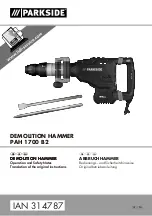
FIXED-BASE ROUTER - 054-6908-8
FIXED-BASE ROUTER - 054-6908-8
25
26
Feeding the router
(fig 14)
fig 14
ROUTER FEED
ROUTER FEED
ROUTER
END
GRAINS
FIRST
ROUTER FEED
ROUTER FEED
DIRECTION
DIRECTION
DIRECTION
BIT
ROTATION
DIRECTION
The secret to professional routing is to set-up for the cut carefully, selecting the proper cutting depth,
knowing how the cutter bit reacts in the workpiece, and selecting the appropriate rate and direction of
feed for the router.
Direction of feed for external cuts
(fig 14)
The router motor and cutter bit rotate clockwise. This means that the feed of the cutter bit must
be from left to right. Feeding the bit from left to right will cause the bit to pull the router toward (up
against) the workpiece.
If the router is fed in the opposite direction (right to left), the rotating force of the cutter bit will tend
to push the bit away from the workpiece, making it hard to control. This is called “Climb-cutting,” or
cutting in the direction opposite the proper feed direction.
“Climb-cutting”
increases the chance for loss of control, resulting in possible personal injury. When
“climb-cutting”
is required (e.g., backing around a corner), exercise extreme caution to maintain
control of the router.
OPERA
TING INSTR
UCTIONS
Because of the high speed of the cutter bit during a proper feeding operation (left to right), there is very
little kickback under normal conditions. However, if the cutter bit strikes a knot, an area of hard grain
in the wooden workpiece, or a foreign object, the normal cutting action may be affected, which may
cause “kickback”.
This kickback may cause damage to the workpiece, and could result in loss of control of the router,
causing possible personal injury. Kickback is always counter-clockwise, or in the opposite direction of
the clockwise rotation of the cutter bit.
To guard against and help prevent kickback,
plan the set-up and direction of feed so that the
router is constantly thrust into the workpiece, keeping the sharp edges of the cutter bit continuously
biting straight into new (uncut) wood (workpiece). Also, always inspect the workpiece for knots, hard
grain, and foreign objects that could cause a kickback problem.
Direction of feed for internal
cuts
(figs 15 and 15a)
When making an internal cut, such as a groove,
dado or slot, always position the guide (edge
guide, straight edge, board guide) on the right-
hand side of the router as the cut is made
(fig 15).
When the guide is positioned on the right-hand
side of the router, the router travel should be
from left to right, and “counter-clockwise” around
curves
(fig 15)
. This counter-clockwise action
around the curve could cause
“climb-cutting”
.
Always be alert and exercise extreme caution
in order to maintain control of the router when
making this type of cut around curves.
When the guide is positioned as shown in fig 15a,
the router travel should be from left to right, and
clockwise around curves.
If there is a choice, the set-up in fig 15 is easier
to use, but there is the possibility of
“climb-
cutting”
around curves. In either case, fig 15 or
fig 15a, the lateral thrust of the router cutting is always against the guide, as is proper.
WARNING!
Always clamp the workpiece securely and keep a firm grip on the router base with
both
hands
at all times. Failure to do so could result in loss of control, causing possible serious
personal injury.
OPERA
TING INSTR
UCTIONS
fig 15
GUIDE OUTSIDE
BIT ROTATION
BIT ROTATION
ROTATION FEED DIRECTION
GUIDE
THRUST
fig 15a
GUIDE INSIDE
BIT ROTATION
BIT ROTATION
ROTATION FEED DIRECTION
GUIDE
THRUST
Summary of Contents for 054-6908-8
Page 1: ...INSTRUCTION MANUAL FIXED BASE ROUTER 054 6908 8...
Page 21: ......







































